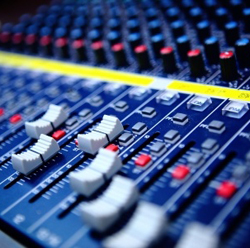
Many consoles include direct output jacks and channel inserts for each channel. The direct outputs can be used to feed another console like a monitor desk or recording board, or they can be used to feed a multi-track recorder directly. Insert jacks are used to “loop” a processor into the signal chain. These are still popular on analog desks that don’t have tons of processing on every channel.
The insert is usually a 1/4-inch TRS (Tip/Ring/Sleeve conductor) and a special insert cable that breaks out the TRS into two regular 1/4-inch plugs. One plug is connected to the Tip and is the send, while the other plug is connected to the Ring and is the return. Processing such as compression, reverb, and delay units can be inserted into a channel, and the effects are then applied to only that input.
Fine Tuning
The next stop for the audio signal in a channel is usually the EQ section. This can be as simple as a bass and treble control with fixed center frequencies, or a multi-channel parametric EQ section that enables the user to choose a center frequency, boost or cut that frequency, and adjust the width of the boost or cut with a control often labeled “Q” or “Bandwidth.”
Both larger analog and digital consoles may also offer pass filters, which pass audio above or below the selected frequency and roll off everything on the other side of the frequency. High-pass filters are great for removing low-end stage rumble that finds its way into vocal mics as well as for any low end sounds you don’t want mics (i.e., drum overheads) to pick up and amplify.

Equalizing (EQing) an instrument or voice is usually a matter of taste, but there are a few tricks that I’ve found over the years that can help get a better sound out of the PA. The first is to remove stuff that does not need to be amplified, like the aforementioned rolling off of the low end of vocal mics with a high-pass filter.
However, I don’t stop there, also electing to get rid of the ultra-high end of many things onstage. For example, I just mixed an Oktoberfest with a band that used a tuba for the bass parts. I know that a tuba does not reproduce harmonics past 4 to 6 kHz, so I rolled off everything above 6 kHz to eliminate the tuba mic from picking up the adjacent cymbals.
Another thing that EQ can be used for is making similar instruments sound slightly different so they can be better distinguished in the mix. Take two guitarists, for instance. They might be playing similar guitars, amps, and even the same chords, so they’re likely to sound pretty much the same in the PA. EQ each guitar a bit differently and there will be definition of each in the mix (and PA). They’ll still sound like guitars, just not like each other.
Sometimes it’s tough to exactly identify an offending frequency that is making something sound wrong. Working with parametric EQ during setup and/or sound check can help. Boost the signal with a very narrow bandwidth and sweep it around until the problem sounds even worse. Now that the problem frequency has been found, cut it until things sound better.
Supplemental Facilities
The subsequent destination is usually the auxiliary sends, referred to as aux sends or “auxes.” Equipped with volume knobs, they can send the audio signal to a separate output. Depending on the console, some may be configured as pre fader (the channel fader), some as post fader, and some may have a pre/post switch to allow the user to configure the send as needed. Some consoles also allow users to configure the sends as pre EQ and post EQ, giving the user the option to have the channel EQ affect the send.
Normally, pre fader sends are used for stage monitors and feeds for recording, while post fader sends are commonly used to send a signal to effects processing like reverb and delay units, or to provide audio feeds at different locations. Most small consoles have mono aux sends, while larger consoles may offer stereo sends, complete with a pan control.
